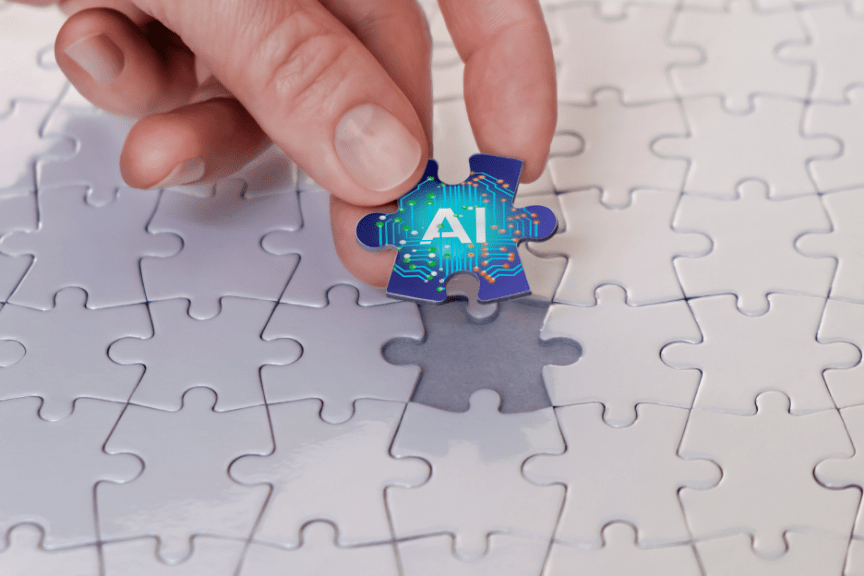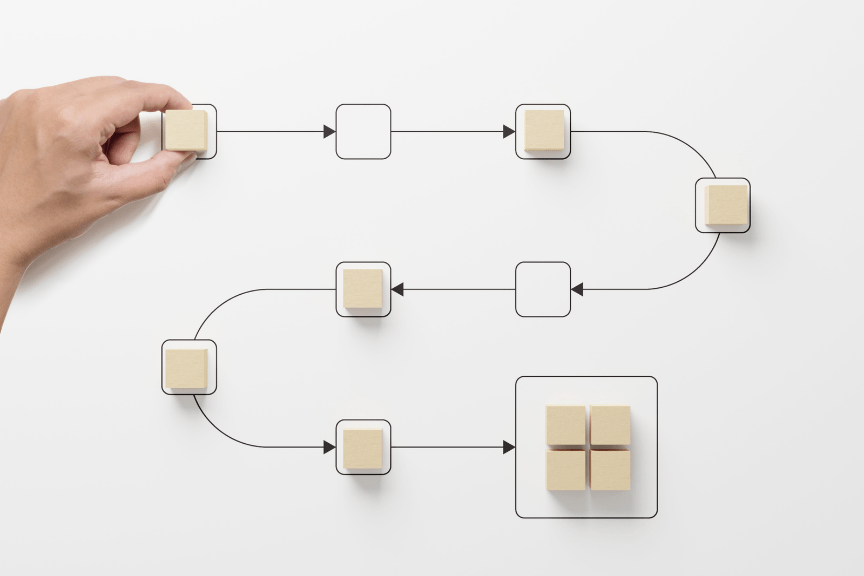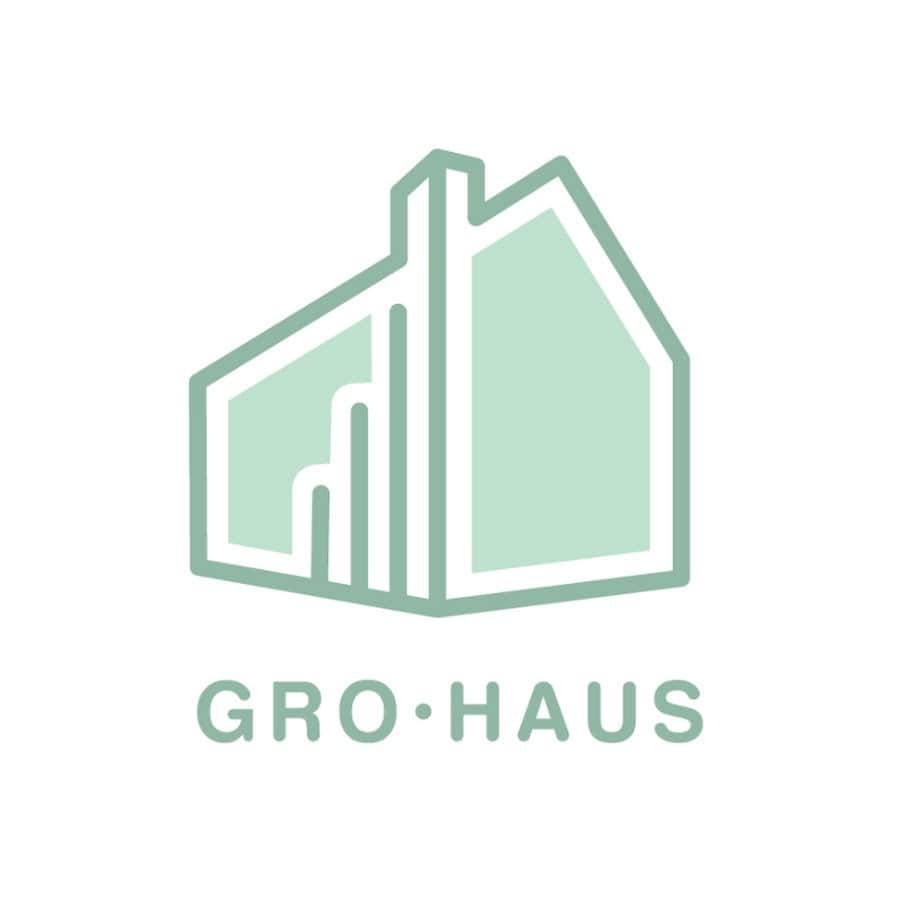Introduction:
In the fast-evolving world of digital marketing, artificial intelligence (AI) has gone from a buzzword to a game-changer. More than 90% of marketing organizations now use AI in some form, and agencies that lag behind risk losing their edge. Today, we take an inside look at how one innovative agency – Gro-Haus – is harnessing AI to transform how they generate leads, automate workflows, and serve clients. Gro-Haus’s founder and CEO, Drew Donaldson, recently shared his journey on our AI Chronicles podcast, showing us insights into how his team leverages AI for hyper-targeted marketing and what lessons other businesses can take away.
Gro-Haus is a data-driven marketing agency specializing in hyper-targeted B2B lead generation, AI-powered automation, and return-on-ad-spend optimization. In simpler terms, they focus on getting their clients’ message in front of exactly the right prospects at the right time – and doing it efficiently. Let’s explore how Drew evolved Gro-Haus from a one-man coaching venture into an AI-augmented agency, and how you can apply the same principles in your own business.
The Gro-Haus Story
Like many entrepreneurs, Drew Donaldson didn’t start off running a high-tech agency. In fact, Gro-Haus began as a marketing coaching business. Drew would advise companies on strategy, but soon found that clients needed more than advice – they wanted execution. “We had built these relationships with clients and they didn’t want to go anywhere else,” Drew recalls of those early days, explaining why he “reluctantly started [an] agency as a way to calm the rioters.” What began as a side service quickly turned into a major profit center. Over time, Gro-Haus shifted fully into an agency model to implement the strategies Drew had been teaching.
One area that set Gro-Haus apart was a deep expertise in B2B lead generation. In business-to-business marketing – especially for high-ticket services – not all leads are equal. You can have thousands of people signing up for an ebook or webinar, yet only a tiny fraction are real potential buyers. Drew learned early that quality trumps quantity when it comes to leads. The key was finding decision-makers who actually have intent to buy, rather than blasting messages to random contacts. This philosophy of quality-led lead generation became the cornerstone of Gro-Haus’s services.
As digital data and ad platforms evolved, Gro-Haus continually refined its methods to target leads more precisely. Enter the concept of “hyper-targeting” – using advanced data to zero in on prospects showing signals that they’re in the market for a particular solution. Drew’s team got “really, really good” at this over the years, combining traditional marketing know-how with cutting-edge data sources. By the time artificial intelligence tools started exploding onto the scene, Gro-Haus was perfectly poised to take things to the next level.
Using Buyer Intent Data to Find Ready-to-Buy Prospects
When Drew talks about hyper-targeted lead gen, he means going beyond basic demographics or broad email lists. Gro-Haus taps into buyer intent data – the digital breadcrumbs that indicate someone is actively researching or considering a purchase in your category. How does this work? Think about all the websites you visit where you accept cookies, fill out forms, or download resources. Those actions create a trail of data about your interests and intent. There are large networks (often called co-registration networks) that pool this anonymous behavioral data. Companies like Bombora, ZoomInfo, and others specialize in gathering and selling these intent signals to marketers.
Drew explains that by buying into these data streams, Gro-Haus can know who’s “in-market” for a given product or service right now. Instead of simply purchasing 1,000 contact leads from a database and hoping some are interested, they can filter for the 200 that have recently shown intent. “I don’t really need a thousand leads because 800 of those aren’t going to do anything,” Drew says. With intent data, his team can “eliminate those 800, give you 200 that are in-market, and run much more efficient campaigns.”
This targeted approach dramatically boosts marketing efficiency. It’s not just theory – industry research backs it up. Campaigns that use intent data have significantly higher performance than generic outreach. For example, one study found intent-driven ads were 2.5× more efficient and achieved a 220% higher click-through rate on average. And importantly, those clicks tend to convert better: 93% of B2B marketers report increased conversion rates when leveraging intent data in their strategy. The reason is simple: you’re reaching people who are already signaling interest, rather than cold contacts.

Doubling Down on Artificial Intelligence
Drew Donaldson has actually been dabbling in AI and machine learning long before ChatGPT became a household name. Early on, he experimented with writing his own algorithms in Python to solve specific marketing problems. “It was always something where if you had a very specific thing to solve, maybe we can do it with machine learning,” he says of those days. However, building custom AI models was time-consuming and narrow. One project took “hundreds and hundreds of hours” of coding and tweaking to get the algorithm working just right – a level of effort hard to justify for most marketing tasks.
That all started to change in late 2022 with the breakout of OpenAI’s ChatGPT. The emergence of powerful, general-purpose AI that anyone could use was a watershed moment. Gro-Haus saw an opportunity to leap ahead by integrating AI into their workflow. By mid-2023, generative AI models (GPT-3.5 and the early GPT-4) had improved enough to handle real marketing content tasks – at least at a basic level. And Drew had a pressing pain point AI could solve: content creation bottlenecks. As a seasoned copywriter himself, Drew was personally writing enormous volumes of copy – from ad headlines to landing pages to email sequences. He knew the systems and structures that worked, but producing them from scratch for every client campaign was labor-intensive. “Writing them all out manually is just very time consuming,” he says, especially when juggling multiple clients and also running the business.
So the question became: Could an AI writing assistant capture Drew’s expertise and save time? This is where Gro-Haus’s AI journey truly kicked off. The initial experiments weren’t glamorous – if you’ve ever opened ChatGPT and typed “Write me a cold email sequence,” you know the output can be painfully generic. Drew expresses that the raw GPT outputs are “pretty terrible” and he’s right. Simply asking for an email or ad copy often yields boilerplate results that sound bland and robotic. Generic AI content isn’t going to wow clients or persuade customers, so Drew approached the task methodically.
He dove into prompt engineering, which is the craft of writing effective inputs to guide the AI’s output. “Back then your prompts had to be structured so carefully,” Drew notes, recalling the early ChatGPT (GPT-3) era. He iterated on instructions and context to feed the model, essentially teaching it how to write in Gro-Haus’s style (aka multi-shot prompting). This wasn’t an overnight success – Drew and his team invested hundreds of hours testing different prompt structures, examples, and refinements until the AI consistently produced good drafts. It was a lot of front-loaded work (“I wish I had [GPT-trainer] when I was starting this,” he laughs), but gradually the AI’s copy quality went from awful to acceptable to impressive.
By late 2022, around the release of GPT-3.5, Gro-Haus had a few AI-generated copy models they felt confident enough to pilot with real clients. They integrated these quietly into their production process. For instance, if they needed to deliver three variations of Facebook ad copy, Drew would write two by hand and let the AI generate the third, all following the same brief. The client would review the trio without knowing which was AI-written – and more often than not, they approved the AI-generated one along with the others. In live campaigns, some of these AI-crafted ads even outperformed the human-written versions. This was the proof Drew needed that the technology was ready for prime time (at least for certain uses).
Importantly, Gro-Haus didn’t (and still doesn’t) position their service as “AI-generated marketing.” They position it as great marketing, enabled by whatever tools make sense. Early on, there was still stigma around AI content – many assumed it’s low-quality or inauthentic. By keeping the focus on results rather than the sausage-making process, they eased clients into the AI-assisted approach.
For Gro-Haus, embracing AI early provided a competitive advantage. It allowed a small agency to punch above its weight in terms of output and innovation. But Drew is careful to emphasize that AI is a means to an end, not a magic button. Let’s look at how exactly Gro-Haus uses AI in practice and the impact it’s had on their operations.
AI Copywriting at 10× Faster
The first big AI win for Gro-Haus was in copywriting – generating the text for ads, emails, and webpages that fuel their clients’ campaigns. Drew’s approach was to essentially train the AI to write the way he would. Through prompt engineering, he imbued the AI with the structures and tone that decades of experience taught him are effective. Instead of a two-sentence instruction, he fed it detailed guidelines: the target audience, the value proposition to highlight, the desired style (e.g. playful vs. professional), and even examples of past successful copy to mimic.
This intensive setup paid off. Now, when a new client project comes in, Gro-Haus can produce draft copy at astonishing speed. “It massively sped up client engagements,” Drew says. An ad or email that might have taken him several days of back-and-forth can now be drafted in hours or even minutes. In fact, he often has a solid first draft ready before the kickoff call with the client. Imagine coming into an initial meeting and being able to show the client: “We’re thinking something like this,” with a sample ad already written. It creates a “surprise and delight” moment and compresses the timeline from idea to execution dramatically.
Gro-Haus’s investment in fine-tuning their prompts essentially trained their AI copy assistant to be an extension of their team. And it’s getting hard to tell the difference between AI and human writing. In a recent poll, 74% of marketers admitted they can no longer confidently distinguish AI-written text from human-written. Drew has seen this first-hand when clients approve AI-crafted copy without batting an eye – the content is doing its job and doesn’t scream “robot.”
That said, Drew is the first to caution that AI is not infallible. It often writes in a way that’s technically correct but lacks a certain finesse. For example, early on his AI would often start emails with phrases like “I hope you’re doing well.” It’s a polite greeting, but in a short prospecting email, it’s wasted space and feels formulaic. A human marketer knows to cut straight to the point in a busy person’s inbox. The AI, left to its own devices, doesn’t inherently know that – it’s just repeating common patterns (remember, AI prioritizes pattern recognition and efficiency over creativity). This is why Gro-Haus always applies a human editorial eye to AI outputs. They trim the fluff, add any missing nuance, and correct any awkward phrasing or cultural references that the AI might not get quite right.
Accelerating Workflows and Improving ROI
By integrating AI into its workflow, Gro-Haus has dramatically improved its operational efficiency and even client satisfaction. Projects that used to take weeks are now turned around in days. For clients, this speed means they can start seeing results (leads, traffic, sales conversations) faster than before, which is a competitive advantage in itself. Internally, Gro-Haus can handle a larger volume of work without needing to proportionally increase headcount.
Lead generation and advertising are ultimately judged by metrics – clicks, conversions, cost per acquisition, return on ad spend. Gro-Haus’s hyper-targeted approach, amplified by AI efficiency, tends to drive strong metrics for clients. Remember those in-market lead lists and AI-optimized ad copy? When combined, they make marketing campaigns both precise and persuasive. It’s not uncommon for Gro-Haus campaigns to meet or beat industry benchmarks for performance. Drew mentioned that some AI-generated ads performed at or above the level of human ones. This aligns with broader trends: companies that adopted AI in marketing have seen substantial uplifts in outcomes. According to Salesforce research, 7 in 10 marketers using AI have improved the overall customer experience, and algorithms can increase lead volumes by up to 50% through better targeting and personalization.
Another impact is consistency. By encoding best-practice frameworks into an AI (via prompt templates and guidelines), Gro-Haus ensures that every piece of output hits certain quality standards or follows the proven formula. It’s like having a junior copywriter who has read all of your playbooks and never deviates from them. This consistency is great for maintaining brand voice and messaging across hundreds of assets. And if a client ever needs a rapid turnaround on something (say a new email blast reacting to a timely event), Gro-Haus can oblige without breaking a sweat.
From an operational cost perspective, while there is a subscription cost for using AI platforms (and some cost for API calls if using something like OpenAI’s API), these are generally far less than hiring additional full-time staff for the equivalent output. It’s been said that AI won’t replace marketers, but marketers who use AI may replace those who don’t. Gro-Haus exemplifies this – they can do more with the same team, which makes them more competitive and profitable.

Next Up - Agentic AI for Workflow Automation
Content creation was just the beginning. Gro-Haus is now exploring the next wave of AI in marketing: intelligent automation agents. These are like mini AI programs that can perform actions, not just generate text. For instance, an AI agent could be set up to automatically pull a list of prospects from a database, send them a personalized introductory email, follow up a week later, and even update the CRM with responses – all without human intervention. In theory, it’s like having a virtual assistant or an extra employee that works 24/7.
Drew is excited about the potential here, but he’s also candid that today’s AI agents still have a long way to go. “They’re just not ready for prime time,” he admits. He gave a simple example: building an agent to check Google Calendar availability and schedule meetings. It sounds straightforward – connect to the calendar API, find open slots, email a meeting invite. But in practice, he found the current agent frameworks (such as those built on GPT-4 with tools like LangChain or Zapier integrations) can be brittle. The agent might get confused if an API call returns unexpected data, or the prompt might not hold enough context for the agent to decide correctly. Sometimes the agent would work in testing but then fail in a real scenario due to a slight change (like a different calendar format or a network delay).
Anyone who has played with early “AutoGPT” or similar autonomous AI systems has likely faced similar frustrations. They can be very impressive for a demo – chaining together tasks based on a goal – but they’re not yet as reliable as hard-coded software for critical processes. Drew likens it to seeing a Ferrari in a dealership window: it looks amazing and you can imagine driving it, but the dealership is closed – you can’t quite use it yet.
That said, progress is happening fast in this area. New APIs and agent frameworks are being updated constantly. Drew predicts that in the coming year or two, many routine marketing tasks will be automatable with AI agents. Gro-Haus is actively building expertise here so they can offer it to clients as soon as it’s viable. One service they foresee is helping companies set up and maintain AI-driven automations. This maintenance aspect is important – unlike traditional software that might run unchanged for years, AI systems often need continuous tuning. Models like OpenAI’s get updated (e.g. a prompt that worked great in GPT-3 might behave differently in GPT-4). Integrations might break when APIs change. There’s also the need to monitor outputs to ensure the AI isn’t drifting off course or producing errors (the dreaded “AI hallucinations” where the system outputs false information confidently).
Overcoming AI Implementation Challenges
By now you might be thinking, “This sounds great, but implementing AI in my business seems daunting.” You’re not alone in that concern. While adoption of AI in marketing is accelerating, there’s a well-documented skills and knowledge gap. A recent study updated in 2025 found that 96% of marketers have at least partially integrated AI into their strategies, yet only 38% feel they’ve fully integrated it successfully. In other words, almost everyone is trying it, but many suspect they’re not doing it right or getting the full value.
The biggest hurdles marketers cite are lack of understanding and lack of training on AI tools. It’s one thing to dabble with ChatGPT; it’s another to build a robust AI-driven workflow like Gro-Haus did. In fact, 71.7% of non-adopters say a simple lack of understanding is the main thing holding them back. And even among those using AI, nearly 43% say they don’t know how to get the most value out of generative AI systems yet. This knowledge gap is a real issue – it means a lot of companies might try AI, get mediocre results (like generic outputs, or error-prone automations), and then sour on the technology prematurely.
Gro-Haus’s experience underscores that success with AI isn’t plug-and-play. Drew spent those hundreds of hours fine-tuning prompts for a reason – out-of-the-box, the AI didn’t magically understand his needs. The reality is, achieving what Gro-Haus did may require expert guidance or significant trial and error. As the saying goes, “garbage in, garbage out.” If you don’t craft the right inputs and process around an AI, you won’t get gold out of it.
One solution that’s emerging is to bring in external AI expertise. In fact, about 40% of companies have already brought in AI experts or consultants to help their marketing teams make the most of this new tech. The payoff can be significant, as 95% of companies that adopted AI report it’s helping them achieve effective marketing strategies.
This is precisely the idea behind GPT-trainer. GPT-trainer’s approach is to build and manage custom AI solutions for businesses, so they don’t have to struggle through the trial-and-error themselves. As our podcast host - Kyle - quipped, “Trying to set up AI on your own is like trying to build a house from scratch. Sure, you could do it, but the time and frustration aren’t worth it.” Using professionals who live and breathe AI can be “a thousand times faster and safer,” he argued – and Drew’s journey gives that claim credibility. Gro-Haus succeeded because Drew had a background in AI and spent an extraordinary amount of time honing the system. Most small businesses don’t have a Drew or that kind of time available; they’re experts in real estate, or healthcare, or e-commerce, not in prompt engineering or large language models.
So if you’re reading this and feeling overwhelmed at the prospect of implementing AI, take heart. You have options: you can invest in training your team (which you should to some degree regardless), and you can leverage outside help. The important thing is not to sit on the sidelines. The data we’ve seen makes it clear that AI-enhanced marketing is not a passing fad – it delivers concrete benefits, from higher conversion rates to time savings to better customer personalization. The gap between those who master it and those who don’t is likely to widen. As Drew saw with some old-school marketers who refused to adapt: the market won’t wait for them.
A smart way to start is to identify one or two high-impact use cases in your business where AI could help. Maybe it’s automating a repetitive manual task, like generating weekly analytics reports. Or maybe it’s improving content creation like Gro-Haus did, or using an AI chatbot to triage customer service inquiries. Start small, get a quick win, and build from there. Engage experts for the heavy lifting if needed, and focus your energy on how to best use the AI outputs rather than how to code them.
Conclusion: The Human-AI Partnership is the Future
Gro-Haus’s journey into AI-powered marketing shows what’s possible when new technology is approached with a clear goal and an open mind. In a relatively short time, Drew Donaldson transformed how his agency operates – making lead generation more precise, content creation faster, and workflows smoother. The result was not just internal efficiency, but better outcomes for clients: more leads, lower ad spend waste, and quicker campaign launches. They achieved this not by seeing AI as a magical solution, but by treating it as a powerful tool in skilled hands.
For businesses still on the fence, now is the time to take action. The gap between AI-powered marketers and those sticking to old methods is widening. Fortunately, getting started has never been easier. Resources abound, from free AI tools to communities sharing prompt tips, and partners like GPT-trainer that can guide implementation. Whether you’re a lean startup or a large enterprise, there’s a path to integrate AI at a scale that makes sense for you.
Interested in implementing AI in your own marketing but not sure where to begin? Consider scheduling a consultation with GPT-trainer's AI implementation specialist. As Drew’s experience shows, having expert guidance can save countless hours and headaches.

